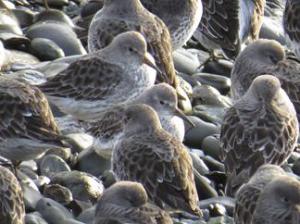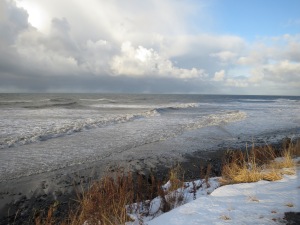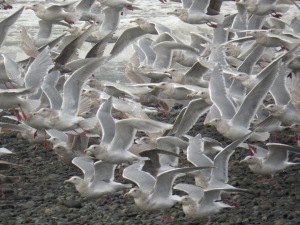Many migrant birds ‘head south’ for the winter – think warmer climates….. Rock Sandpipers (Calidris ptilocnemis) – are truly hardy wintering shorebirds of Cook Inlet Alaska for they call Homer home for the winter – think freezing temps….. In Homer we enjoy flocks of up to several thousand Rock Sandpipers gathering at the banana belt of Homer serving as the ‘warmer climes’ migration spot. A flock can reliably – okay almost always, be found hanging out at the Homer Boat Harbor during high tide when their feeding habitat is inundated with water. Look for them, thousands stand out, along the northeastern side of the boat harbor. Some are even doing the polar plunge, bathing in the water. And its fun to watch them if you can withstand the cold, harsh winds and temperatures that can hit Homer at times.
Smaller flocks of Rock Sandpipers generally can be found at the Anchor River beach, foraging along the shoreline. The best times to search for these hardy birds is October through December – takes a hardy birder to brave the weather. But remember, timing is everything when it comes to birds.
Not all Rock Sandpipers call Cook Inlet home during the winter months. Rock Sandpipers can also be found wintering along the western coast of the United States from the Aleutian Islands to northern California, as well as British Columbia. Oh, and occasionally they have been found in China and Japan.
Did you know there are four subspecies of Rock Sandpipers? And we have occasion to get up to three subspecies in the Homer area: C.p.tschuktschorum, C.p.couesi, and C.p.Ptilocnemis during the winter months. The first two are hard to tell apart, however the third subspecies – c.p.ptilocnemis – is much lighter in color than the other two subspecies.
Facts
- Winters farther north than any other North American shorebird – along rocky seacoasts, breakwaters, and mudflats.
- Breed in grassy or mossy tundra in coastal or montane areas in Alaska and Russia.
- Feeds on amphipods, small crustaceans, clams, snails, barnacles, seeds, berries, moss, algae, and marine worms.
- The female lays 2-4 eggs in a nest in a depression in the ground.
- Both parents incubate the eggs – about 20 days.
- The chicks are precocial – leaving the nest and feeding themselves shortly after hatching.
- Both parents care for the young.
- The chicks fledge around 21 days old.
Shorebirds are one of my favorite species of birds so it is nice to have at least one shorebird species hanging around our area during the winter months.
Sources:
(Cornell Lab of Ornithology – All About Birds: http://www.allaboutbirds.org/guide/Rock_Sandpiper/lifehistory; http://birdweb.org/birdweb/bird/rock_sandpiper#; http://www.nhptv.org/wild/rocksandpiper.asp; and http://birdnote.org/show/rock-sandpipers-are-tough)





































Recent Comments